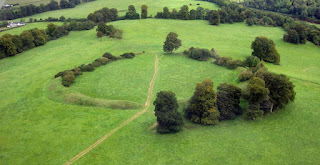 |
| Site Q, the giant henge of Dowth. |
That townland is Callystown, which has generally been translated as Baile na gCailleach, the "town of the nuns". Tradition says that there was once a nunnery at Callystown, hence the name. But the issue is not as straightforward as that. The Cailleach was an ancient goddess, revered in prehistoric Ireland in places far and wide. She was known in some places as the Cailleach Bheara / Cally Vera, and although long since reduced to the paltry stature of a "hag" or "crone", it seems that at one time she was a female deity held in very high esteem. Indeed I would draw comparisons between the great Cailleach and goddesses such as Bóann and maybe Brigid, but I will save that for another day.
We know that the Cailleach was revered in this region in ancient times. The hills of Loughcrew, upon which sit ancient passage-cairns that are older than Newgrange, Knowth and Dowth, are called Sliabh na Caillighe - the hills of the witch/hag/crone/old woman. She is said to have formed the cairns upon Carnbane East and Carnbane West as she jumped from peak to peak, carrying an apron full of stones, some of which she dropped as she jumped. Curiously, the same story describes the construction of the round tower at Monasterboice in County Louth. According to folk tradition, gathered in the Schools Folklore Collection, the round tower was formed by the Cailleach dropping stones from her apron. In one version of the tale, the Cailleach becomes the Virgin Mary. In another version, she slips from the top of the tower and is killed in the fall to the ground. Not too far away is a stone age wedge tomb called the "Cailleach Bhirra's House". Monasterboice is only six or seven miles west of Clogherhead.
I've long wondered if the Callystown area of Clogherhead was perhaps named more anciently than the arrival of the nuns. Richard and I made a strong case in Island of the Setting Sun for a link between the goddess Bóann and the Moon and Milky Way. Similar connections could be made with the Cailleach, who was venerated all over Ireland and whose name survives in many townlands and even on the Beara Peninsula in Cork, along Ireland's southern extremity.
Thanks to the widespread availability of historical sources on the internet, it now seems as though I've been able to answer that question, or at the very least to throw some doubt and intrigue on the matter. According to an article on the history of the 'Ancient Parish of Clogher and Kilclogher' on the Clogherhead Development Group website, the nuns arrived in Callystown at the turn of the Sixteenth Century.
Writing in 2003, Liam Mac Raghnaill said: "In 1508, a small community of nuns, known as the Black Nuns, arrived at Callystown, where they held 128-acres, a cottage and possibly a small church. They are believed to have moved from Termonfeckin to Callystown as a result of a dispute with the Lord Primate of the time. The convent buildings were thought to have been situated near to the site where Callystown House was later built, but no trace remains."
The case would appear to be closed. Clogherhead's Callystown is so called because the Black Nuns lived there from the Sixteenth Century. However, I decided to reference the Online Placename Database of Ireland (Logainm.ie) to see what further information, if any was available, could be gleaned about this place name.
 |
| Callystown and Castlecoe Hill on Google Maps. |
1301 Balykellath
1416 Calyaghtoun
1426 Kylkloghir
1431 Kaillaghton
1431 Cayllaghton
1440 Caalaghton
1471 Kallyaghtown
This last spelling, the one immediately preceding the arrival of the nuns, is almost definitely a rendition 'Cailleach' or 'Cailliagh' and 'town'. So there was a nun in Callystown before the nuns! Or, at least, a hag/crone/ancient goddess - call her what you will.
Because of the prominent position of Callystown/Castlecoo Hill as a horizon "marker" for summer sunrise from the great Boyne Valley monuments, and because of the very strong association of those monuments and their river valley with the goddess Bóann, it should be possible to at least re-consider the origin of Callystown, and to acknowledge the possibility of another inception for its name.
It is, of course, still possible that there was some sort of nunnery or convent at Callystown before the arrival of the Black Nuns. Interestingly, there is a place at nearby Termonfeckin called 'Nunneryland', and we were told the old Irish name for that place was 'Cailleach Dubh', possibly meaning 'Black Nun'. Because Cailleach also means "veiled one", there is a tendency to associate the word with nuns. But as previously stated, the Cailleach is one of Ireland's most ancient divinities. Cailleach Dubh can also refer to the cormorant (a bird), but in her guise as a goddess, the Cailleach Dubh is found even in Scotland.
Local tradition in Termonkfecin suggested that there was once an old laneway that ran all the way from Nunneryland to Callystown. Declan Quaile, writing about the old townlands and placenames of the area, said that: "Callystown was always pronounced ‘Calliaghstown’ by the old people, harking back to the original Irish word." Wikipedia has some interesting information about the Cailleach.
What might be even more fascinating about the apparent connection between Callystown and the Brú na Bóinne monuments is that the hill doesn't precisely mark sunrise on summer solstice, but is probably a more comfortable fit with the rising of the full moon at the time of its northern extreme. Did the ancient monument builders of the Boyne once upon a time see the full moon rising out of Castlecoo Hill at a significant astronomical moment, and did they then name that sacred hill in honour of the great goddess of creation? We might never know, but we can speculate . . .








